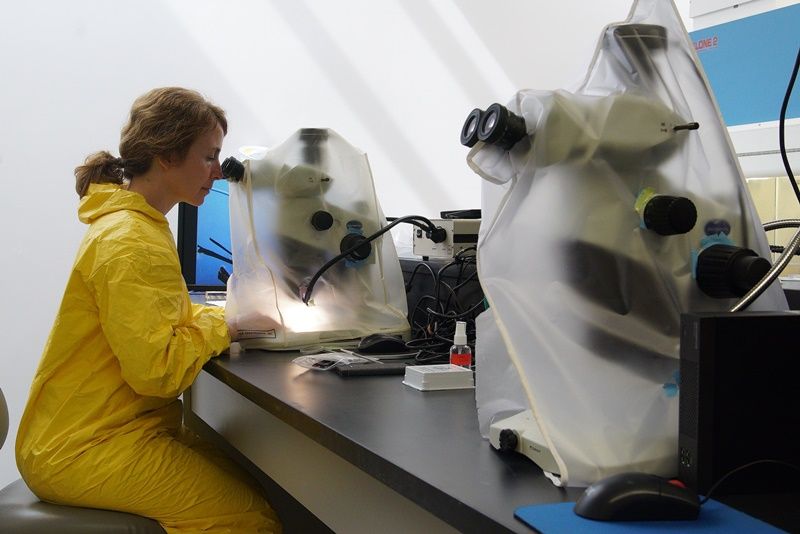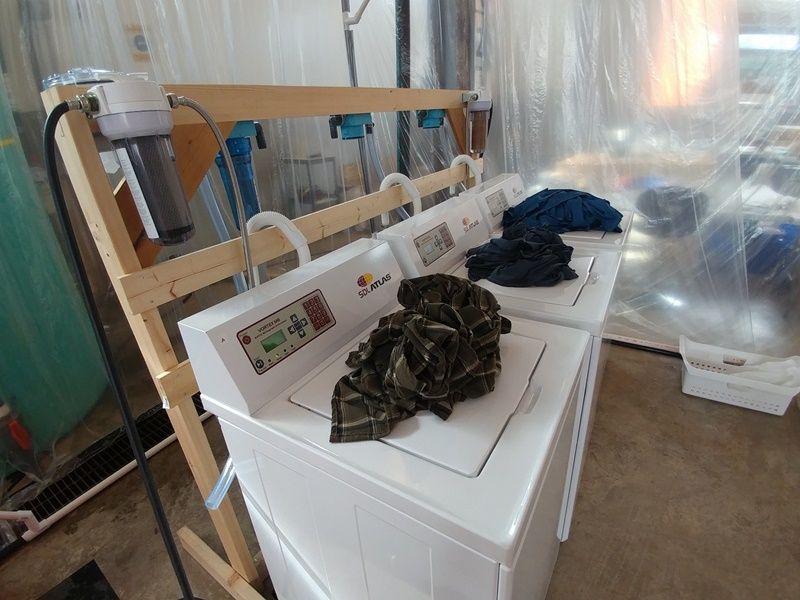New Report: Laundry Releases Trillions of Plastic Microfibers Into the Ocean
Published on by Water Network Research, Official research team of The Water Network in Science
Ocean Wise releases the most comprehensive study to date on the role of laundry in microfiber pollution. The study estimates that 878 tonnes of plastic microfibers are released from Canadian and U.S. household laundry through wastewater treatment plants every year. This is the equivalent weight of 10 blue whales collectively into rivers, lakes and oceans.
Microfibers found in our laundry (Image: CNW Group/Ocean Wise)
A new study demonstrates that the fight against ocean pollution begins at home.
With microplastic pollution now understood to be an emerging threat to ocean health, the Ocean Wise Plastics Lab in Vancouver, British Columbia, Canada, investigated one of the potential sources of this problem. Authors Katerina Vassilenko, Mathew Watkins, Stephen Chastain, Anna Posacka and Peter Ross note that the loss of fibers by textiles during home laundry may explain in part the abundance of microfibers found in the ocean.
The report, entitled Me, My Clothes and the Ocean: The role of textiles in microfiber pollution , was produced with the support of four outdoor retailers – MEC, Patagonia, REI and Arc'teryx – and Metro Vancouver and Environment and Climate Change Canada.
The most comprehensive study to date
With limited research on the propensity of textiles to shed during laundry, the researchers' goal was to generate a wider dataset on the microfiber footprint of different fabrics. Over a two-year period, the Plastics Lab evaluated the shedding properties of 37 textile samples constructed with polyester, nylon, and natural and mixed fibers. The Plastics Lab team established a custom-designed washing machine test facility and a dedicated high-resolution analytical laboratory, both in Vancouver.

Working at the Ocean Wise Plastics Lab in Vancouver, Canada (Image: CNW Group/Ocean Wise)
One of the key findings was the surprisingly wide range in shedding exhibited by different textiles tested during a single wash, reflecting variations in construction, yarn type, mechanical treatment and chemical treatment of each item. For example, mechanically-treated polyester fleeces and jerseys typically shed the most, whereas lightweight and durable nylon textiles shed the least. And while concerns linger regarding the emission of synthetic fibers through home laundry, even materials made with natural fibers such as cotton and wool released large amounts of microfibers.
In this study, the researchers estimate that the average household in Canada and the U.S. releases 533 million microfibers – or 135 g – from laundry into the wastewater treatment system every year. Following wastewater treatment, that adds up to a collective release by households in both countries of 3.5 quadrillion (3.5 x 1015) microfibers – or 878 tonnes – to the aquatic environment (freshwater and ocean). That's the equivalent weight of 10 blue whales – every year.
"Our overall hope is that these findings provide a conduit to solutions at multiple levels," said Dr. Peter Ross, the Vice-President of Research at Ocean Wise and one of the authors of the report. "These results illustrate the important role that we can all play in implementing solutions through the decisions we make as consumers, the green design options we choose as manufacturers, the designs we employ as wastewater treatment engineers, and the initiatives we lead as policymakers in government."

Working at the Ocean Wise Plastics Lab in Vancouver, Canada (Image: CNW Group/Ocean Wise)
Microplastics are mistaken for food in the ocean
This work is part of a wider Plastics Lab initiative to characterize the identity, fate and effects of microplastics in the world's oceans. One of the major problems associated with microplastics is that they can be mistaken for food and ingested by biota, including zooplankton, fish and marine mammals.
How consumers can help
Apparel makers and retailers will benefit from this research as a foundation for designing textiles that are less prone to microfiber shedding. Consumers can also help reduce microfiber pollution in the following ways:
- Wash textiles less often
- Buy products designed to last and say "no" to fast fashion
- Use a front-loading washing machine
- Buy a lint trap for your washing machine
- Let clothing firms know that this is important to you the consumer, and ask that they design fabrics that shed less
About Ocean Wise and its Plastics Lab
Ocean Wise is a global conservation organization that is committed to improving the health of our oceans. Through aquariums, education, research and digital communications, we directly inspire tens of millions of people to take actions that will benefit our planet. The Ocean Wise Plastics Lab is a research facility based in Vancouver, British Columbia (BC), Canada, specializing in microplastic pollution science. Established in 2014, the Plastics Lab combines urban- and ocean-oriented study designs, laboratory testing and forensic instrumentation to address the sources, transport and fate of microplastics in aquatic environments. It partners with industry, government agencies, Indigenous communities and academic groups to research microplastic pollution and guide solutions. Its multi-disciplinary research team studies microplastics in home laundry machine effluent, seawater, municipal wastewater/sewage, zooplankton, mussels, fish, and the digestive tracts of marine mammals.
About the Microfiber Partnership
In 2017, the Ocean Wise Plastics Lab launched the Microfiber Partnership, a solution-oriented research initiative that brings together researchers, the apparel industry, and government agencies concerned about the sources and impacts of microfiber pollution in the ocean. Central to this research initiative was the design of a dedicated washing machine test facility, the development of new methods to sample liquid laundry effluent and municipal wastewater, and the characterization of microfiber samples using microscopic image analysis and Fourier Transform Infra Red (FTIR) spectrometry. The Phase 1 research objectives of the Microfiber Partnership addressed three elementary topics:
Home laundry as a source of microfiber in the environment;
Retention, fate and discharge of microfibers in a secondary wastewater treatment plant;
Forensic methods for the identification of textile microfibers following weathering in air, seawater and wastewater.
Source: PR Newswire
Media
Taxonomy
- Micropollutants
- Environment
- microplastics
- Microplastic ingestion